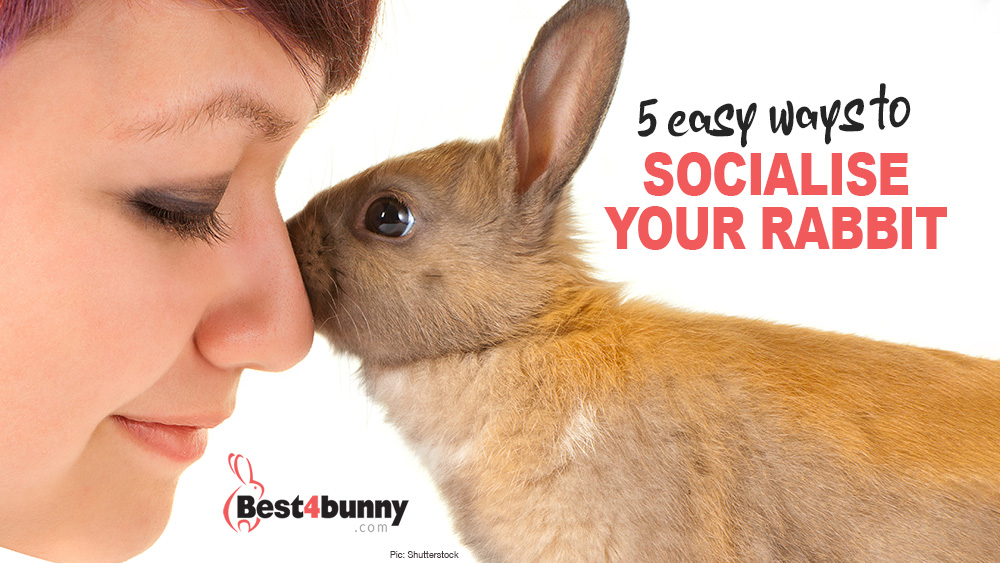
Rabbit socialisation is essential if you want to effectively bond with your new
rabbit. It will also determine how well your rabbit interacts with others of its own
species or even other species, if you have other pets. Here are the basics of socialisation.
Why is socialisation important?
Before we discuss how you socialise your rabbit, we need to mention in more
detail why it is such an important part of rabbit ownership. Rabbits, or more
specifically, lagomorphs, have their own language.
Rabbits are also extremely social animals. They have a hierarchical society just
like dogs. It is not good for a rabbit to be anti-social or isolated.
Socialisation is the best way to prevent loneliness and boredom in your rabbit, and to ensure your
floppy-eared friend thrives.
Proper socialisation creates many positive outcomes. First, it allows you to bond
with your rabbit and fully enjoy living with this amazing, funny animal.
Sometimes rabbits do not naturally enjoy being picked up or handled by humans.
They are prey animals, and so tend to be skittish if not properly socialised.
A second positive outcome of socialisation is that your rabbit will be able to have
a friend. Bonding between two rabbits takes time and may take some of their
focus off of you. However, it helps them lead their happiest lives. Instead of two
rabbits, you can also introduce another species like a dog or cat into the
household. Socialisation is essential in this scenario, as it allows the rabbit to
accept these predators are his or her friends.
Five tips for socialising your rabbit
The five tips presented in this section will ensure proper socialisation and a healthy, happy
rabbit.
1) Keep your rabbit in an x-pen initially.
When you bring a new rabbit home,
keep him or her in an x-pen or a secure location. The x-pen or holding area
should be placed near the rest of the family. The rabbit should be able to
hear and see all of your daily activities. However, by keeping it in an x-pen
for the time being, you are providing it a safe location to take in all of the
new sights, sounds, and smells.
2) Treat often.
Once your new rabbit has worked up the courage to begin
investigating their new surroundings, it is time to break out the treats.
Rabbits respond to treat training like any other pets. Add treats in normal
diet, they love treats. Treat early and often, and the rabbit will begin
associating you with good things, and they will be more likely to approach
other humans as well.
To avoid feeding too many treats, break one treat into bits and give your rabbit one small bit at a time instead of one whole treat.
3) Provide places to hide.
This step is especially important if you have
children in the home or other pets. Rabbits can get easily overwhelmed, especially in a
new environment. It is important to provide them places to hide or rest
when they don’t feel like socialising. This “safe space” can help the rabbit
feel confident enough to continue exploring their new surroundings.
4) Introduce your rabbit to the other animals of the house.
Once your rabbit has begun feeling comfortable in your home, it is time to introduce him or
her to any other pets. Do not rush this process. Make sure the rabbit and other animals are safe throughout. It is also important to watch
body language during this step. If the rabbit’s body language tells you they
are angry, ready to fight, or panicked, remove them from the situation. You
can try again once everyone is calmed down.
5) Go slowly.
Every rabbit is different, and so the socialisation process will
take a unique amount of time for each animal. Do not rush things. Let the
rabbit determine their own pace. And, try to be patient. Once your rabbit
has been socialised and bonded with you and your other pets, you will see
that the time and effort was worthwhile.
Final thoughts
Proper socialisation is just as important for your rabbit as providing for its other
basic needs. Yes, housing, diet, and medical care ensure the longevity and overall
health of your rabbit, but socialising your rabbit is imperative for their mental
health. Socialisation ensures that your rabbit stays happy and active.
Follow the steps above to begin the socialising process and remember to take
your time. It will be worth it, we promise.
Click here to read our blog on How to Bond Bunnies
Author Bio:
I’m Kristin, Education Director at House Rabbit Society. I’m covering the pet world for more than 10 years now. I published my content in the House Rabbit Society, PetMD, Wag, PetFirst, and other sites. I work in conjunction with the Southern Cross Vet team and Flemish Giant Rabbit blog to ensure my advice is reliable and actionable.


